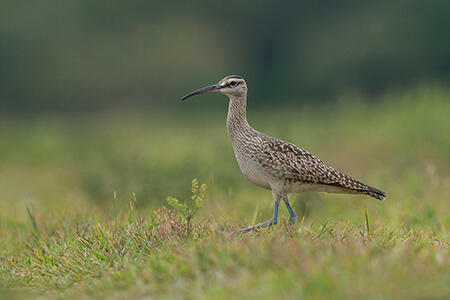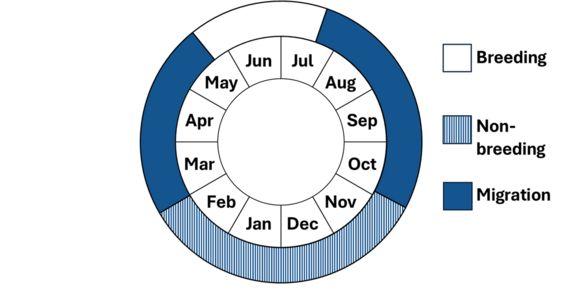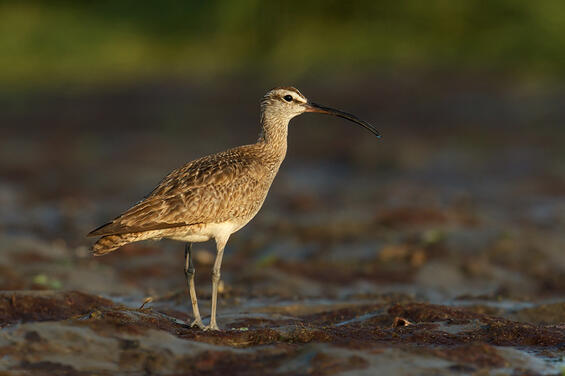- Scientific name: Numenius phaeopus
Species of Greatest Conservation Need (MA State Wildlife Action Plan)
Description

Whimbrel (Numenius phaeopus)
Whimbrels are large, 43–46 cm (17-18 in) long, gray-brown shorebirds, with a long (7.3 – 10.3 cm [2.9-4.1 in]) down-curved bill and striped crown. Its vocalization is 5 to 7 short rapid whistles: ti-ti-ti-ti-ti.
Life cycle and behavior
Whimbrels are migratory. Subpopulations begin their northbound migrations at different times, but most whimbrels are making their way north through April and into mid-May. Arrival at the breeding colony happens as early as the first week in May. Whimbrels have one brood per season. Average clutch size is four eggs and both adults incubate. The incubation period is 22–28 days. Chicks are precocial and mobile soon after hatch. They leave the nest soon after hatch and feed themselves. Little information is available on parental care. Both parents provide care for a few days, with the female departing before chick fledge. Whimbrels’ southbound migration occurs from late Jun to October. Juvenile stay on the breeding grounds about one month later than adults. Age at first breeding and annual survivorship is unknown. The oldest known whimbrel was 12 years old.

Population status
The global whimbrel population is estimated at 1,800,000–2,650,000 mature individuals. The global population is suspected to be experiencing a decreasing population trend, but there are limited data. It is likely that most whimbrel subpopulations are currently stable. However, a recent study indicates a strong and rapid decline for the subpopulation utilizing Atlantic coast migratory sites.

Black-and-white warbler (Mniotilta varia)
Distribution and abundance
Whimbrels are the most wide-ranging of its congeners. They breed in high latitudes in Alaska, northern Canada, Iceland, northern Europe, small pockets throughout Russia. Whimbrels typically winter along the coast of North and South America, Africa, southern Asia, and Australia.
Whimbrels occur in Massachusetts only during migration. They are uncommon in the spring and locally common during fall migration (late July through September), especially in the vicinity of the Monomoy islands and South Beach in Chatham.
Habitat
Whimbrels breed in subarctic and alpine tundra and taiga. During migration, they use terrestrial and coastal habitats such as sandy beaches, rocky shores, river mouths, lagoons, salt marshes, and meadows. On the wintering grounds, they typically inhabit muddy tidal flats and hard mudbanks. The habitats of whimbrels in Massachusetts include coastal mudflats, sand flats, and salt marshes.
Healthy habitats are vital for supporting native wildlife and plants. Explore habitats and learn about conservation and restoration in Massachusetts.
Threats
Destruction or degradation of coastal wetlands, human disturbance during migration, and oil spills are all threats to this species. On wintering areas south of the United States, unregulated hunting and exposure to environmental contaminants (cadmium, for example) are also threats. Climate change will likely impact the global whimbrel population, as severe weather, sea level rise, habitat encroachment, and the spread of invasive species may lead to habitat degradation or loss.
Plastic trash in the environment poses a threat as it can be mistaken as food by seabirds and shorebirds and ingested or cause entanglement. Ingested plastics, common for seabirds, can block digestive tracts, cause internal injuries, disrupt the endocrine system, and lead to death. Entanglement from fishing gear and other string-like plastics can cause mortality by strangulation and impairing movements.
Conservation
Like many shorebirds, current conservation efforts directed towards the identification and protection of migratory staging and wintering sites (i.e. the Western Hemisphere Shorebird Reserve Network) benefit whimbrel populations. However, continual identification of important whimbrel migratory sites is critical.
Future research should include population monitoring and surveying to produce population size estimates and project population trends. Additionally, much of the whimbrel’s breeding biology throughout its range is unknown. MassWildlife’s Natural Heritage Endangered Species Program (NHESP) does not track occurrences of whimbrels in Massachusetts.
Avoid or recycle single-use plastics and promote and participate in beach cleanup efforts.
References
BirdLife International (2024). Species factsheet: whimbrel Numenius phaeopus. Downloaded from https://datazone.birdlife.org/species/factsheet/whimbrel-numenius-phaeopus
Skeel, M. A. and E. P. Mallory whimbrel (Numenius phaeopus), version 1.0. In Birds of the World (S. M. Billerman, Editor). 2020. Cornell Lab of Ornithology, Ithaca, NY, USA. https://doi-org.silk.library.umass.edu/10.2173/bow.whimbr.01
Veit, R., and W.R. Petersen. Birds of Massachusetts. Lincoln, MA: Massachusetts Audubon Society, 1993.
Contact
| Date published: | May 15, 2025 |
|---|